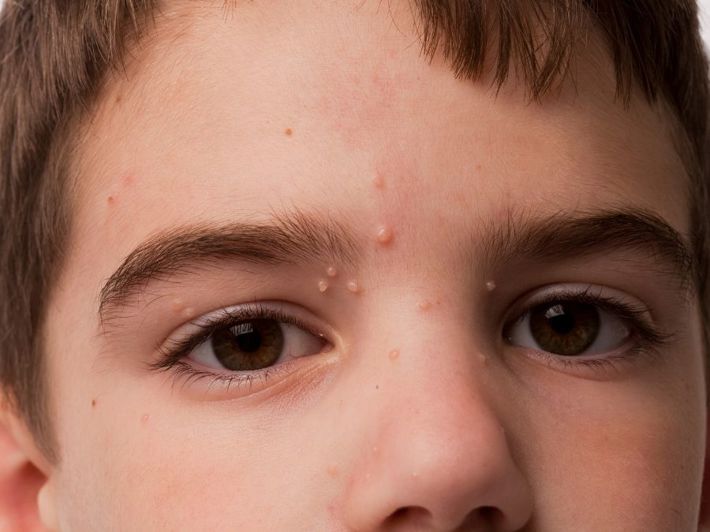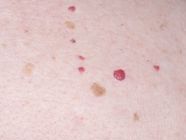Molluscum contagiosum is one of the most common skin infections in children. Learn the most important information about this disease, its signs, how it spreads, and what are the ways to get rid of it.
What is molluscum contagiosum?
- Molluscum contagiosum is a highly contagious viral skin disease that spreads through direct skin contact or through the use of tools contaminated with the virus.
- It has a distinctive appearance; it appears in the form of painless circular blisters or pimples that resemble pearls.
- It is more common in children than adults, usually between the ages of 1 - 10 years. (1)
What does molluscum contagiosum look like?
- Molluscum contagiosum resembles the shape of pearls, in small numbers or hundreds of them.
- The incubation period lasts 2-8 weeks before symptoms appear.
- It appears in the form of pimples or blisters that resemble a smooth dome in flesh, pink, or white color, with a dimple in the middle, and inside it is a white substance that resembles cheese.
- Its size is small, ranging from 2 mm (pinhead) to 5 mm (pencil eraser), and usually increases in size over time.
- It may appear anywhere on the body, most often on the face, neck, arms, legs, abdomen, genital area, or armpits, and rarely on the palms of the hands or soles of the feet.
- It may be accompanied by itching, redness, swelling, or ulcers if inflamed. (2)(3)
Have you noticed strange blisters on your child's skin? Do these blisters resemble the symptoms of molluscum contagiosum? You can now book an appointment at the Dermatology Department at Al-Ahli Hospital, so that our medical team can evaluate your child's condition and provide appropriate treatment.
How does molluscum contagiosum spread?
- Molluscum contagiosum spreads through direct contact with blisters or infected skin.
- Using tools contaminated with the virus, such as towels.
- Going to swimming pools or jacuzzis contaminated with the virus.
- Through sexual intercourse between spouses.
- Molluscum contagiosum is characterized by causing self-infection; That is, the infection can spread to healthy skin areas when the blisters are scratched, and then touching other skin areas. (4)
How is molluscum contagiosum diagnosed?
- Dermatologists recognize molluscum contagiosum by its distinctive appearance, and this is sufficient for diagnosis in most cases.
- In a few cases, a sample may be taken from the blisters and examined under a microscope to confirm the diagnosis. (5)
What is the treatment for molluscum contagiosum?
- Molluscum contagiosum disappears on its own without treatment or any trace; it turns into red blisters indicating that it has begun to disappear, often taking 6-18 months, or sometimes up to years. (2)(3)
- Some creams or ointments may be prescribed to boost immunity and relieve symptoms, such as: imiquimod (Aldara), salicylic acid, tretinoin, and others.
- Oral cimetidine tablets may be used to treat some cases of molluscum contagiosum in children; by stimulating the body's immunity against viruses. (3)(6)
- In some cases where molluscum contagiosum is very widespread or its appearance is undesirable, the blisters can be removed by scraping / curettage under local anesthesia, or by cryotherapy, laser, or electricity, but they often leave scars behind.
How can molluscum contagiosum be prevented from spreading?
- Wash your hands well, especially when touching the blisters.
- Avoid sharing personal items, such as towels and clothes with others.
- Avoid scratching or rubbing the blisters so that they do not spread to other places.
- Wash the child's toys in hot water, because they can be a source of infection.
- Dry the blisters with a specified towel.
- It is best to cover the blisters with a bandage or clothing when going to school or work. (7)(8)
References
1.Caring for Kids: Molluscum Contagiosum Overview
2.CDC: Molluscum Contagiosum Information
3.American Academy of Dermatology: Molluscum Contagiosum Symptoms
4.Mayo Clinic: Molluscum Contagiosum
5.WebMD: Molluscum Contagiosum
6.Cleveland Clinic: Molluscum Contagiosum
7.Health Direct: Molluscum Contagiosum
8.Royal Children's Hospital Melbourne: Molluscum Fact Sheet






